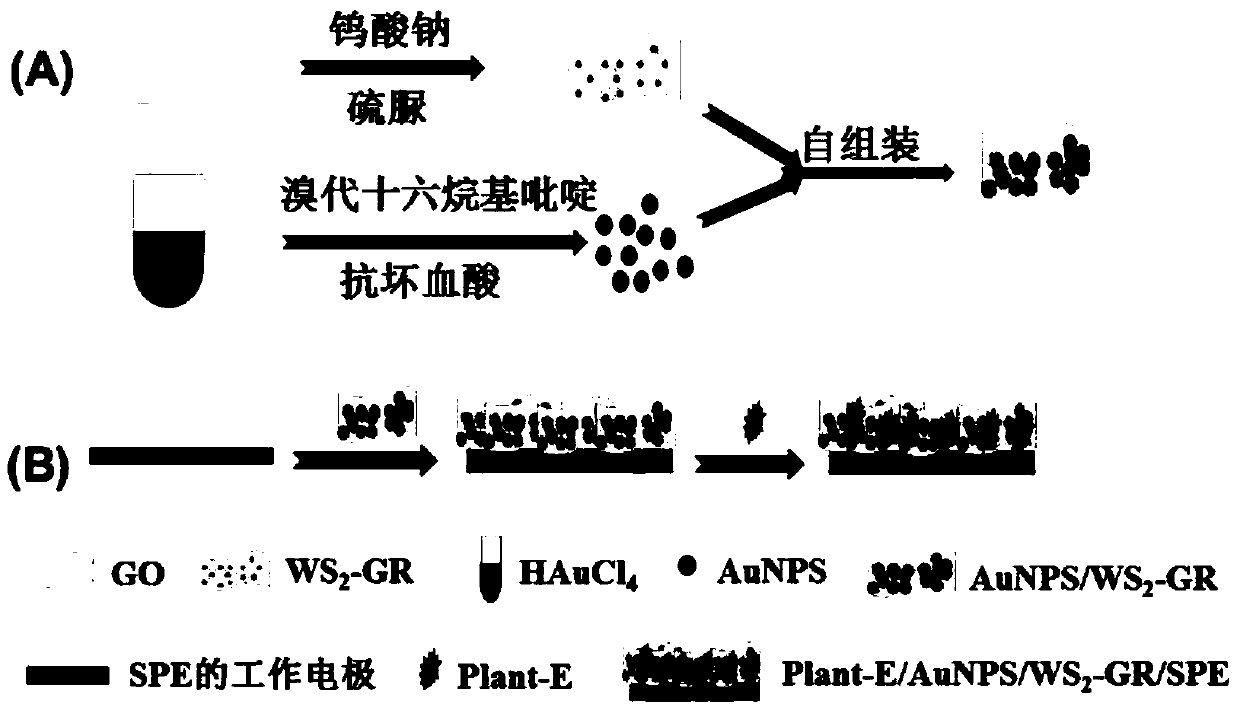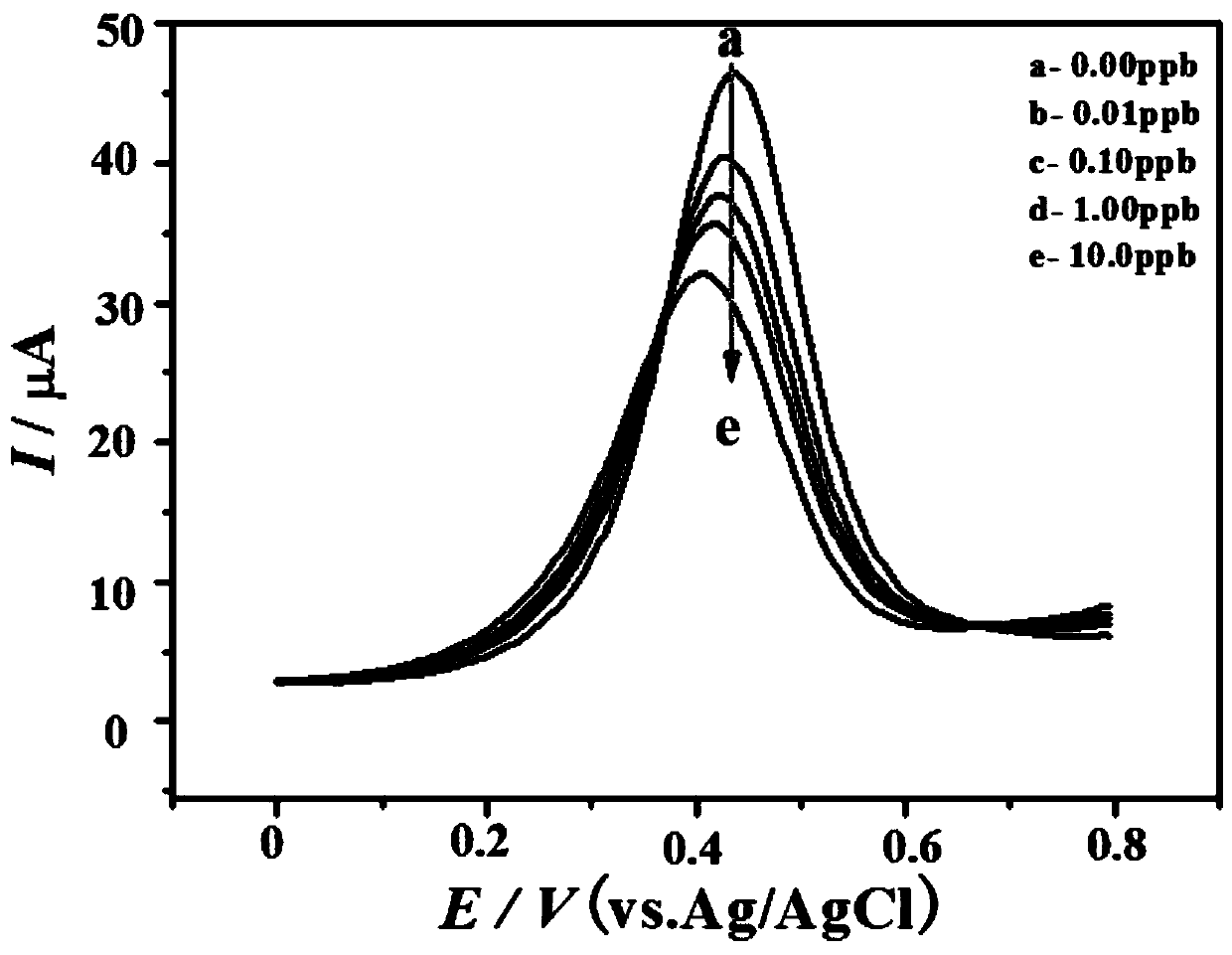Enzyme biosensor for pesticide residue detection and preparation method and application of enzyme biosensor
A biosensor and product technology, applied in the field of biosensing, can solve the problems of difficult real-time and rapid on-site detection, expensive equipment, time-consuming and other problems, and achieve the effects of fast and accurate identification and measurement, low price and good conductivity
- Summary
- Abstract
- Description
- Claims
- Application Information
AI Technical Summary
Problems solved by technology
Method used
Image
Examples
Embodiment 1
[0031] A nano-gold tungsten disulfide graphene composite material AuNPS / WS 2 -GR, its preparation method is as follows:
[0032] 1) Add 0.05g graphene oxide powder GO into 40mL methanol, ultrasonically disperse for 1 hour to obtain a uniformly dispersed graphene oxide methanol solution, then slowly add 0.5g sodium tungstate powder and 0.5g thiourea to the In the methanol solution of graphene oxide, sonicate for 30 minutes to obtain a mixed solution. Subsequently, the mixed solution was transferred to a 100 mL autoclave, and reacted at 180° C. for 64 hours. After the reaction, the reactor was naturally cooled, and the resulting solution was filtered to obtain a black product. The product was washed 3 times with twice distilled water, and the product was dried at 60°C under nitrogen protection to obtain WS 2 Modified graphene WS 2 -GR, spare.
[0033] 2) 20mL 0.2%HAuCl 4 solution and 1g cetylpyridinium bromide were sequentially added to a 50mL centrifuge tube, ultrasonical...
Embodiment 2
[0036] An Enzyme Biosensor Plant-E / AuNPS / WS for Detecting Pesticide Residues 2 -GR / SPE, its preparation method is as follows:
[0037] 1) 1mg of the prepared graphene composite material AuNPS / WS 2 -GR dispersed in 1 mL of secondary water to obtain AuNPS / WS 2 -GR aqueous solution, use a pipette gun to pipette 5 μL of the dispersion solution and drop it on the working electrode of the screen-printed electrode, dry it at room temperature, and use 0.01mol•L -1 Washing with PBS buffer (pH=7.4) to obtain graphene composite modified electrode AuNPS / WS 2 -GR / SPE.
[0038] 2) Prepare plant esterase Plant-E to a concentration of 100U•mL -1 The aqueous solution, the aqueous solution and the chitosan solution with a mass concentration of 0.3% were mixed in equal volumes to form a mixed solution, and 5 μL of the mixed solution was drip-coated on the AuNPS / WS prepared in step 1). 2 - On the working electrode of GR / SPE, dry at room temperature, use 0.01mol•L -1 PBS buffer (pH=7.4) wash...
Embodiment 3
[0041] Application of an enzyme biosensor for detecting pesticide residues in the detection of pesticide residues. The detection object is organophosphorus pesticides (parathion or malathion). The constructed plant esterase electrochemical biosensor is used for detection. The detection principle: The substrate 1-naphthyl acetate is hydrolyzed by plant esterase to produce acetic acid and naphthol (electroactive substances), thereby generating current signals. The inhibition of plant esterase activity by organophosphorus pesticides reduces the electroactive products, so the current signal decreases. Depending on the increase in the content of organophosphorus pesticides, the decrease in the current signal is also different (the detection principle is as follows: figure 2 ). The method is as follows:
[0042] 1) Detection of blank samples: the prepared Plant-E / AuNPS / WS 2 - The GR / SPE enzyme biosensor was immersed in a phosphate buffer solution without organophosphorus pesticid...
PUM
 Login to View More
Login to View More Abstract
Description
Claims
Application Information
 Login to View More
Login to View More - R&D
- Intellectual Property
- Life Sciences
- Materials
- Tech Scout
- Unparalleled Data Quality
- Higher Quality Content
- 60% Fewer Hallucinations
Browse by: Latest US Patents, China's latest patents, Technical Efficacy Thesaurus, Application Domain, Technology Topic, Popular Technical Reports.
© 2025 PatSnap. All rights reserved.Legal|Privacy policy|Modern Slavery Act Transparency Statement|Sitemap|About US| Contact US: help@patsnap.com



